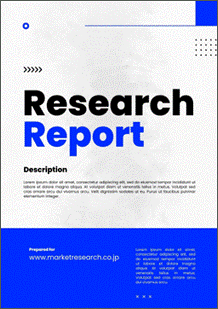 | • レポートコード:D0-MOR-AP1442 • 出版社/出版日:Mordor Intelligence / 2020年4月 • レポート形態:英文、PDF、120ページ • 納品方法:Eメール(受注後2-3営業日) • 産業分類:農業 |
| Single User | ¥555,000 (USD3,750) | ▷ お問い合わせ |
| Team User | ¥629,000 (USD4,250) | ▷ お問い合わせ |
| Corporate License | ¥1,036,000 (USD7,000) | ▷ お問い合わせ |
• お支払方法:銀行振込(納品後、ご請求書送付)
レポート概要
| 本調査レポートは、生物学的有機肥料のアジア市場について調査・分析した資料で、生物学的有機肥料の市場概要、動向、セグメント別市場規模、競争状況、企業情報、市場機会分析などで構成されています。 |
The Asia-Pacific Biological Organic Fertilizer Market is expected to grow at the fastest rate with a CAGR of 6.3% during 2020-2025. Organic fertilizers are derived from many animal plant based residues, mineral ores and also developed from beneficial microorganisms. In India, organic fertilizer is applied in bulk or in concentrate depending on the nutrient level content in the particular concentration of product ingredients. These are low-cost renewable sources of plant nutrients which supplement chemical fertilizers. The selected strains of beneficial soil microorganisms used either for seed treatment or soil application are particularly gaining momentum among farming communities. China accounted for 41.2% of the biological organic fertilizers market share for the Asia-Pacific region in 2018. China’s grasp over key technologies. Production processes of China organic fertilizer have continued for over five decades now, though practical utilization of the same has gained momentum only recently, prompted by a global shift towards the same.
Key Market Trends
Increased Adoption of Organic Farming
According to the Organic Trade Association, approximately 82% of households in the United States purchase organic food. The organic food market in India has been registering a CAGR of 25%. As per Statista, it is anticipated to reach USD 1.36 billion by 2020. The rise in demand for organic products is booming, not only due to an increase in conscientious consumers, but also due to increasing incomes, along with improved farming practices that make organic yields more robust. As a result, the increasing demand for organic food, worldwide, has increased the area under organic farming, worldwide. Increase land under organic cultivation will drive the organic fertilizer market during the forecast period.
China Dominates the Market
The Asia-Pacific region is majorly influenced by the Chinese market. The Chinese economy is moving toward a green agriculture practice by encouraging the farmers to scale back the use of chemical fertilizers and switch to bio-based and organic alternatives. In this regard, in 2017, China’s Ministry of Agriculture released a pilot plan for fertilizer replacement in around 100 districts of China, which aimed at reducing chemical use fertilizer by at least 20% by 2020. At present, the number of organic fertilizer producers has been growing every year. Some larger fertilizer manufacturers have also stepped into the industry. China has over 300 organic producing enterprises with an annual product output of about half a million metric tons.
Competitive Landscape
Asia-Pacific organic fertilizer market is fragmented in nature as there are many players with small shares in the market. Major companies operating in the region are Agrinos, China Bio Fertilizer, etc are adopting various strategies, such as product launches, partnerships, and acquisitions, to gain a larger share in the market. For instance, June 2018 – Kiwa Bio-Tech Products Group Corp has established a cooperative relationship with Postal Savings Bank of China Co. Ltd (“PSBC”), Shaanxi Branch, to provide financial support to its clients, including crop growers, family farms, farmers’ professional cooperatives, and others.
Reasons to Purchase this report:
– The market estimate (ME) sheet in Excel format
– 3 months of analyst support
1 INTRODUCTION
1.1 Study Deliverables
1.2 Study Assumptions
1.3 Scope of the Study
2 RESEARCH METHODOLOGY
3 EXECUTIVE SUMMARY
4 MARKET DYNAMICS
4.1 Market Overview
4.2 Market Drivers
4.3 Market Restraints
4.4 Porters Five Force Analysis
4.4.1 Threat of New Entrants
4.4.2 Bargaining Power of Buyers/Consumers
4.4.3 Bargaining Power of Suppliers
4.4.4 Threat of Substitute Products
4.4.5 Intensity of Competitive Rivalry
5 MARKET SEGMENTATION
5.1 Crop
5.1.1 Grains and Cereals
5.1.2 Pulses and Oil seeds
5.1.3 Fruits and Vegetables
5.1.4 Others
5.2 Form
5.2.1 Dry
5.2.2 Liquid
5.3 Type
5.3.1 Organic Fertilizer
5.3.1.1 Green Manure
5.3.1.2 Oil Cakes
5.3.1.3 Bone Meal
5.3.1.4 Fish Meal
5.3.1.5 Others
5.3.2 Bio-Fertilizers
5.3.2.1 Blue Green Algae
5.3.2.2 Mycoorrhiza
5.3.2.3 Azosprillum
5.3.2.4 Rhizobium
5.3.2.5 Azotobacter
5.3.2.6 Others
5.4 Geography
5.4.1 Asia Pacific
5.4.1.1 India
5.4.1.2 China
5.4.1.3 Japan
5.4.1.4 Rest of Asia Pacific
6 COMPETITIVE LANDSCAPE
6.1 Market Share Analysis
6.2 Most Adopted Strategies
6.3 Company Profiles
6.3.1 Kiwa Biotech
6.3.2 Seek Biotechnology Co. Ltd
6.3.3 Qingdao Future Group
6.3.4 Qingdao Hibong Fertilizer Co Ltd
6.3.5 Jiangsu Hanling Fertlizer Co Ltd
6.3.6 Agri Life Phytopharma Ltd
6.3.7 Bodisen Biotech Inc
6.3.8 Revisoil
6.3.9 National Fertilizer Limited
7 MARKET OPPORTUNITIES AND FUTURE TRENDS